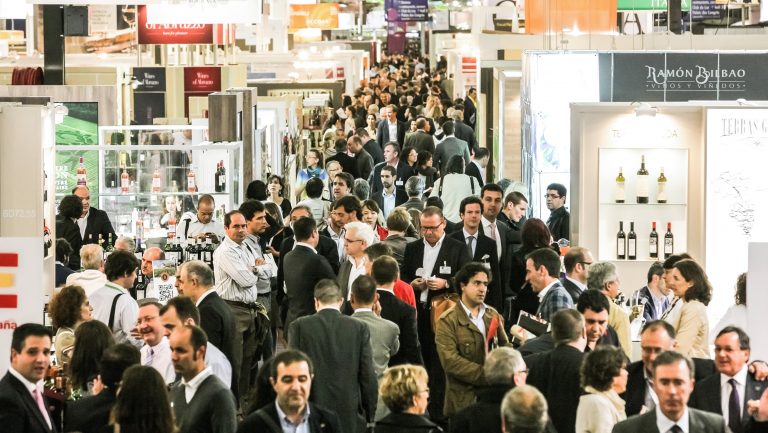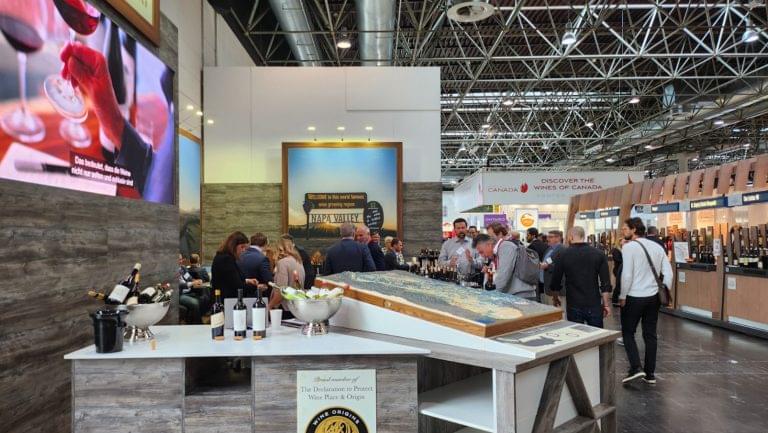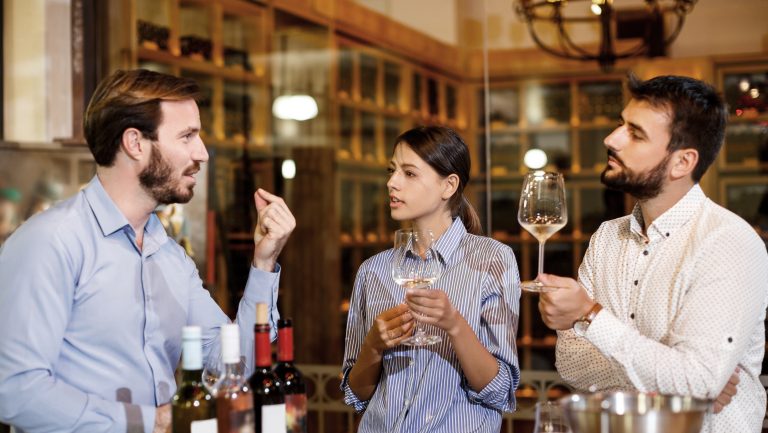For three days this past March, representatives from American wineries manned exhibit booths at the wine world’s largest trade fair—ProWein in Düsseldorf, Germany. However, not all their experiences were the same, as each winery balanced its individual needs to fit the resources committed.
For example, Shafer Vineyards, Chappellet, Heitz Cellar, and Staglin Family Vineyard, among other producers, were all part of a jointly manned Napa Valley Vintners booth, each taking turns pouring and discussing their wines with potential buyers and distributors.
Meanwhile, Paso Robles’ Hope Family Wines paid for a small, single-winery booth within the show’s California Pavilion, sponsored by the California Wine Institute, while the Santa Rosa-headquartered Jackson Family Wines’ worldwide group of wineries met current and potential customers at its own large, freestanding exhibit space.

Don’t miss the latest drinks industry news and insights. Sign up for our award-winning newsletters and get insider intel, resources, and trends delivered to your inbox every week.
For wineries whose production and business plans tempt them to go beyond direct-to-consumer and regional distribution, deciding whether and how to exhibit at trade shows in the U.S. and abroad is an important business decision. And if they decide to try it, getting the most out of the experience is key to whether their long-range plans will succeed.
“To be a world-class winery or wine region, you need to be seen and sold around the world,” says Connor Best, the senior director of global marketing for Napa Valley Vintners and leader of a group of about 20 wineries at ProWein. “It’s also important to go meet the customers, and since you can’t get to smaller markets every year, you may be able to all get together at a trade show.”

Weighing the Cost Versus Benefits of a Trade Show
The primary reason for a winery actively taking part in a trade show is to find an importer or distributor who will expand its market reach. But, as Best notes, there are many reasons to take part: to expand into newer markets or redirect existing ones; to meet with existing accounts to review annual performance and set goals; to make your brand more recognizable in all markets; to promote your brand story to a diversity of trade and consumer media; and to shop around at other booths for goods or services your winery might need. In some cases, trade shows can also help a winery look for partnerships or ventures with other winegrowers.
“While the costs for this three-day trade show, including travel, expenses, and booth fees, is pretty hefty, [Prowein] is attended by 60,000 people from nearly 150 countries,” says Joe Lange, the international sales director for LangeTwins Family Winery and Vineyards near Lodi, California. “While my main focus in the first year was identifying new importers, the show now serves as a convenient meeting place to connect with our current importers to discuss our collective businesses and to meet with potential new partners.”
Austin Hope, the owner of Hope Family Wines, says his company attends shows in Singapore, Toronto, and Montreal in addition to Germany and also uses them as stepping-off points for visiting regional partners. Speaking as ProWein 2023 was ending, Hope says, “Our export director, Meliza Jalbert, will do an auxiliary visit to Zurich tomorrow to host wine events and support the effort of our local distributor.”

How to Optimize Your Time at a Wine Trade Exposition
Attendees, winemakers, and event producers discuss how to prioritize and manage your time at large-scale events
Multi-brand, international firms such as Jackson Family Wines can also use trade shows as a group meeting point to plan with colleagues before or after the show. “We showcased over 120 wines representing 35 brands from Oregon, California, Australia, France, Italy, and South Africa,” explains international marketing manager Tiffany Stewart.
With these opportunities in mind, a winery considering attending a show for the first time needs to weigh benefits against costs. Most wine regions offer group pavilions, either with joint activities or in small, connected booths with a table and chair, and they usually pick up part of the costs. For a beginner, this is the least expensive way to start. Best estimates that booth fees, product, and travel and lodging costs for a three-day show will begin at around $5,000 and go up depending on additional activities. And, he warns, “I never guarantee success.”

Research and Preparation for a Show Is Key
Veteran trade show exhibitors and those who run them say doing a good job of advance planning, paying attention to logistics before and during a show, and being active in all venues during an exhibit determine whether there will be a positive answer to the question every potential exhibitor asks: “Will it be worth what we’re spending?”
It’s important to research the event in advance, even if an association is handling logistics. “Most questions we receive are specifics about booth space, pricing, regulations, shipping, and so on,” says Dan Howard, the managing committee member for Unified Wine & Grape Symposium, the annual industry show in Sacramento, California. “Exhibitors should study our website for information,” says Beckie Kier, who manages the annual Vinexpo America show in New York City. “Once they arrive, it’s a turnkey package with everything set up for them, from tables to wine glasses provided.”
For exhibitors that move up to having their own free-standing booth, there are companies who specialize in custom building, shipping, and setting up exhibits. “We had five clients at ProWein, including associations such as Napa Valley Vintners and wineries like [Chateau] Ste. Michelle and Wölffer Estate,” says Barbara Orr, a co-owner of Poretta & Orr, a major booth builder, “and we had our people there to help all during the show.”
For wineries exhibiting as part of a pavilion, all that’s needed is booth signage, table decorations, winery and product literature or digital displays, and bottles of wine. Associations generally oversee shipping. “Bringing along a tablet to display our latest photography from the winery and vineyards has proven to be eye-catching and informative,” Lange suggests.

It’s also important to remember that trade shows and their attendees aren’t all alike. “At most conventions, we target bulk wine clients and those companies wanting private labels,” says Brian Drivas, the private and control label manager for Four Feathers Wine Services in Eastern Washington. “But at Vinexpo in New York, we were looking for restaurant and retail customers for our own labeled wines.”
Planning client meetings and trying to get into the show’s programming need to be done far in advance. “I tell my clients to see if you able to take part in a seminar, a group event or a winemaker dinner,” says Katherine Jarvis, the head of public relations firm Jarvis Communications. “And can they meet with key media or trade in the area or partner with a wine store for a tasting?” The bigger the show, the more competition there is for scheduling meetings, and larger companies excel at this. “At ProWein, we had over 145 scheduled meetings spanning the entirety of the globe with new and existing partners as well as key media outlets and regional organizations,” says Stewart.
Follow Up After the Show
“I spend most of my flight home working on my follow up, such as emails to all new contacts with requests to connect again soon and more detailed follow-up with existing partners on the specific topics we discussed at the show,” says Lange. For Hope, “Our success is measured primarily by how many more countries we sign up to distribute our wines.”
Of course, it’s natural to try to catch up on work left behind as soon as the excitement of the show is over. “While we do pre-show strategy sessions,” says Drivas, “we also meet soon after the show to be sure there is swift follow-up.”
Not that everything can be wrapped up quickly. “I tell new exhibitors that things may move more slowly after the show, but you have to continue to work at it,” says Best. “It may take a year or more before a new contract is signed and the winery receives the first order. So the more rapport you have after the show, the better.”
And, at the same time post-show activities are being completed, action items for next year’s show, such as meetings and dinners, are beginning to shape agendas—and it’s time to start the process all over.

Dispatch
Sign up for our award-winning newsletter
Don’t miss the latest drinks industry news and insights—delivered to your inbox every week.
Roger Morris is a Delaware-based writer who for the past 20 years has contributed articles on wine, food, and popular culture to about a dozen publications in the U.S. and Europe. Currently, he writes for World of Fine Wine, Drinks Business, Meininger’s, VinePair, Wine & Spirits, and Global Drinks Intel, among others. In prior years, he taught writing at Arizona State University and the University of Delaware and was an industry marketing executive.







